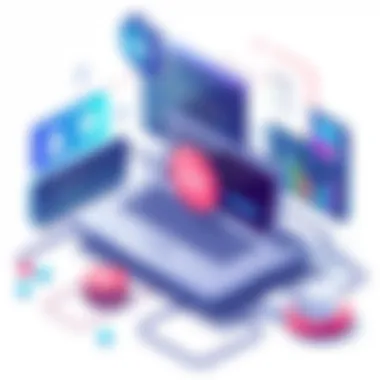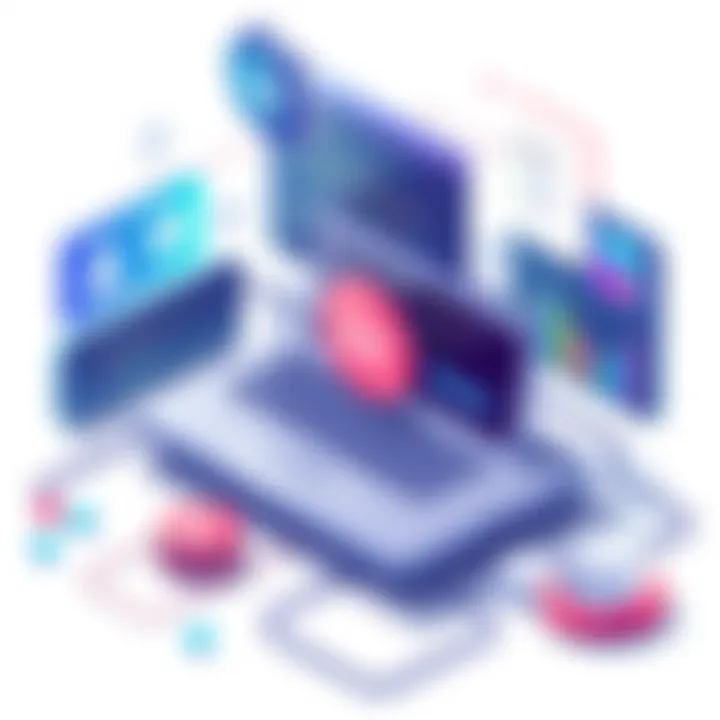In-Depth Guide to Mobile Device Management Tools


Intro
In the fast-paced world of technology, managing mobile devices effectively has become not just a convenience but a necessity. Organizations are finding themselves sifting through a sea of mobile device management (MDM) tools, each promising to deliver enhanced security and streamlined processes. Knowing the ins and outs of these tools can make a huge difference in how well a business can safeguard its data and ensure compliance with various regulations.
Mobile Device Management tools differ widely in terms of features and capabilities. These tools can range from simple applications that secure devices to comprehensive platforms that provide extensive monitoring and management capabilities. Understanding the nuances of each tool can help tech leaders optimize their resources and bolster security measures across the organization.
This comprehensive overview seeks to demystify the landscape of MDM tools. We'll explore key aspects such as the purpose and importance of these solutions, current trends shaping their development, and metrics for evaluation. Through a detailed analysis, we aim to equip decision-makers and IT professionals with the information they need to navigate their choices skillfully.
Prolusion to Mobile Device Management
In the fast-paced world we live in, where technology evolves quicker than a rabbit on a caffeine buzz, organizations are more reliant than ever on mobile devices. From smartphones to tablets, these gadgets have become crucial locks on the doors of productivity. Yet, the convenience of mobile technology also comes with its share of head-scratchers—security issues, device management, application control, and the delicate balancing act of user freedom versus corporate control. Herein lies the significance of Mobile Device Management (MDM).
Definition of
Mobile Device Management is the umbrella term used to describe a set of tools and practices utilized by organizations to manage and secure mobile devices deployed across their workforce. By using MDM solutions, companies can remotely monitor, manage, and secure employee devices, ensuring that critical data remains protected even in a world of rogue applications and pesky cyber threats. Essentially, MDM acts as a security bridge connecting the organization’s data and the devices accessing it.
Importance of in Today's Environment
In today's increasingly mobile-centric workplace, MDM has become a bedrock for maintaining both functionality and security. Let’s break down why MDM is not just a nice-to-have but a need-to-have:
- Data Security: Mobile devices can often be a weak point in an organization’s cybersecurity infrastructure. With MDM, businesses can enforce security protocols like data encryption and password policies, shielding sensitive information from prying eyes.
- Loss and Theft Mitigation: Devices slip from hands and pockets all the time—it's just a part of life. MDM tools allow for features like remote wipe, ensuring that if a device is lost or stolen, sensitive company data doesn’t fall into the wrong hands.
- Regulatory Compliance: Many industries are bound by strict regulations regarding data management. MDM makes it easier to comply with these regulations by monitoring devices and maintaining records of data access and usage.
"In the modern business environment, managing devices isn’t just about convenience; it’s about safeguarding an organization's digital assets."
- Efficiency Boost: By simplifying the management of devices and applications, organizations free up IT teams to focus on more strategic initiatives rather than time-consuming manual checks or interventions.
In summary, Mobile Device Management isn't merely a component of IT management; it has evolved into a cornerstone of a secure and efficient workplace. Its relevance has grown so much that without it, organizations may find themselves in a sticky situation—vulnerable and inefficient. As the digital landscape continues to shift, understanding the intricacies of MDM becomes indispensable for any tech-savvy professional aiming to safeguard their organization’s productivity and security.
Core Features of Tools
In an era where mobile devices are at the forefront of business operations, understanding the core features of Mobile Device Management (MDM) tools is paramount. These functionalities not only streamline the management of devices but also bolster the overarching security and efficiency within an organization. As companies increasingly adopt mobile-first strategies, adopting comprehensive MDM solutions directly impacts operational success.
Device Inventory Management
Device inventory management serves as the cornerstone for any MDM strategy, akin to knowing what’s stocked in a warehouse before making further plans. This feature continuously monitors and catalogues all devices linked to the corporate network. It allows IT administrators to ensure that they are using the right tools for the job – keeping track of everything from smartphones to laptops.
Moreover, keeping an updated list of devices helps in identifying potential security vulnerabilities that could arise from unmonitored or outdated hardware. Think of it as a digital roll call that keeps your organization’s assets accounted for and ready.
App Management
App management under MDM includes installation, update, and configuration of applications used across corporate devices. With the average employee juggling multiple applications daily, controlling what apps get used is crucial. This tool provides the IT department with the ability to push updates seamlessly and remove unauthorized applications that might pose security risks.
For instance, if a new vulnerability is discovered in a widely-used app, MDM can quickly deploy an update across all devices or block the app entirely, saving significant time and mitigating risk for the organization. It’s like having a gatekeeper that knows which tools employees can use, ensuring alignment with corporate policies.
Policy Enforcement
Policy enforcement is like setting the rules in a game; without it, chaos will ensue. MDM allows companies to enforce security policies on all enrolled devices, making sure these rules are consistently applied. This can range from password requirements to restricting access to sensitive data, promoting compliance with both internal standards and regulatory requirements.
One major perk is the ability to push configurations or restrictions in real time, ensuring that no device is left unmonitored or misconfigured. It's crucial as organizations operate under a set of guidelines — not following them can lead to severe consequences, both financially and in reputation.
Security Features
Security features embedded within MDM tools are indispensable in today’s threat landscape. The protection of sensitive data and organizational assets relies on several key components, including:
Data Encryption
Data encryption protects sensitive information at rest and in transit. When devices interact with each other or with networks, encryption ensures that even if data is intercepted, it remains unreadable. One standout characteristic of data encryption is its role in safeguarding customer information, and it's vital for compliance with various regulations like GDPR or HIPAA.
However, it's worth noting that while encryption is extremely beneficial, it may cause a slight delay during data retrieval, as the encrypted data requires decryption. Nonetheless, the security benefits significantly outweigh such concerns, making it a reliable choice in effective MDM practices.
Remote Wipe
Remote wipe functionality allows organizations to erase data on a device from a distance, a critical capability especially if a device is lost or stolen. It’s a safety net that ensures sensitive information doesn’t fall into the wrong hands. Key here is that the ability to perform a remote wipe is often a lifesaver for many companies, averting potential data breaches before they can escalate.


But there are challenges too. Remote wipe needs to be configured correctly; an accidental wipe could mean lost data, impacting productivity. Thus, careful implementation is essential.
Device Lock
Device lock features serve as the first line of defense against unauthorized access. If a device is left unattended, the ability to lock it remotely can save critical data from being compromised. This functionality works in tandem with user authentication measures to ensure that only authorized personnel access sensitive information.
However, similar to the other features, using device lock requires a thoughtful approach. Locking out users at inappropriate moments can lead to frustration and hinder daily operations. Thus, context is key, making sure that the lock function enhances security without intruding on user experience.
"The right features in MDM tools not only protect assets but also streamline operations, ensuring both efficiency and peace of mind for management and users alike."
When businesses leverage these core features effectively, they secure their mobile environments while maximizing productivity and compliance.
Market Overview of Tools
In today's technology-driven world, Mobile Device Management (MDM) tools play a pivotal role in ensuring that organizations can efficiently and securely manage a plethora of mobile devices. The increasing reliance on mobile solutions has led businesses to recognize the need for robust management capabilities that go beyond mere device provision. Consequently, this market has flourished, featuring a variety of solutions each tailored to meet diverse organizational needs.
Understanding the market overview of MDM tools provides valuable insights into the options available, helping decision-makers select a solution best aligning with their objectives. The current landscape showcases both established players and emerging competitors, placing emphasis on features such as security, usability, and integration capabilities.
This information is particularly crucial for IT leaders and business professionals aiming to streamline operations while maintaining high security standards. As companies navigate through compliance regulations and data protection laws, MDM tools not only support operational efficiency but also bolster the organization’s security posture. In essence, a clear view of the MDM market paves the way for informed decision-making that can significantly affect an organization’s mobile strategy.
Leading Solutions
Microsoft Intune
Microsoft Intune is a prominent player in the MDM realm, seamlessly integrating with existing Microsoft ecosystems. One key characteristic of Intune is its exceptional ability to manage both mobile and desktop devices from a single dashboard, making it an appealing choice for organizations already leveraging other Microsoft products.
A notable unique feature of Intune is its Conditional Access, which allows administrators to set up policies that restrict access to organizational resources based on compliance status of devices. This provides an added layer of security that helps safeguard sensitive information. However, while the breadth of features is indeed advantageous, some users have reported a steep learning curve that could pose a challenge for organizations without dedicated IT support.
VMware Workspace ONE
VMware Workspace ONE offers a comprehensive platform that combines MDM and identity management. Its key characteristic lies in the ability to deliver personalized experiences across devices while ensuring security and compliance. Workspace ONE’s unified endpoint management (UEM) approach allows businesses to tailor access based on user roles and device types.
One notable unique feature of Workspace ONE is its Work Conditional Access feature, which not only secures applications but also enhances user experience by streamlining the authentication process. Despite its strong features, some companies find it visually complex, which might hinder quick navigation and setup for teams unfamiliar with similar platforms.
IBM MaaS360
IBM MaaS360 is designed to optimize security measures while offering robust management capabilities. Its standout characteristic is the solid analytics and reporting functionalities that provide organizations with deep insights into device usage and security status. This analytical approach supports data-driven decisions and helps in mitigating risks associated with mobile device management.
A unique feature of MaaS360 is its IBM Watson integration, which uses AI to enhance management and security capabilities. This advanced feature can help identify potential threats proactively. However, the sophisticated nature of its capabilities may necessitate additional training for users to fully leverage its potential.
Emerging Players
MobileIron
MobileIron is known for its strong focus on security and user privacy, positioning itself as a serious contender in the MDM space. The key characteristic of MobileIron is its mobile security architecture that prioritizes the protection of both data and user identity. This is crucial as organizations increasingly adopt mobile strategies that involve sensitive information.
A distinctive feature of MobileIron is its Security First approach, which includes tools for continuous threat assessment. This is particularly advantageous for enterprises in highly regulated sectors. Nonetheless, businesses considering MobileIron should be aware that its sophisticated feature set may require experienced IT personnel to implement effectively, which could lead to increased support costs.
Cylance
Cylance has carved a niche in the MDM market by emphasizing AI-driven security measures aimed at preventing malware attacks. Its key characteristic is the proactive use of artificial intelligence to anticipate potential security threats before they manifest. This forward-thinking approach is tailored particularly for organizations needing to fortify their security landscape.
One of its unique attributes is the application of machine learning techniques to identify suspicious activities and patterns. While Cylance’s novel approach is a strong competitor in the security domain, it may be less comprehensive in terms of device management features compared to other established tools, potentially limiting its appeal for organizations looking for all-in-one solutions.
Jamf
Jamf specializes in Apple device management, making it a favorite among organizations heavily invested in Apple's ecosystem. The key characteristic of Jamf is its seamless integration with Apple devices, allowing for easy management and provisioning.
A unique feature of Jamf is its emphasis on user empowerment, which is reflected in its self-service capabilities, enabling users to independently install applications and updates. This can significantly reduce the workload on IT departments. Despite these advantages, organizations with diverse device types may find Jamf’s focus on Apple products somewhat limiting when compared to more generalized MDM solutions.
"A strong overview of the MDM market equips businesses with the knowledge to navigate choices that align perfectly with their strategies and security needs."
As organizations continue to employ mobile technologies, the landscape of MDM is expected to rapidly evolve, fostering innovations that meet emerging business requirements.


Comparative Analysis of Tools
The comparative analysis of Mobile Device Management (MDM) tools stands as a critical area in this review. This section is designed to help readers understand the various options available in the market and how they stack up against each other. The importance of analyzing features, pricing, and user experience cannot be understated, as the choices made here can greatly influence an organization’s operational efficiency and security posture. Here, we will explore key factors which should be considered when evaluating MDM solutions, thus empowering IT professionals and decision-makers to make informed choices.
Feature Comparison
When diving into the feature comparison of MDM tools, it’s essential to consider the specific capabilities that align with an organization’s needs. Not all MDM solutions offer the same functions, leading to varying degrees of effectiveness for different situations. Here are some features that typically require close evaluation:
- Device Management Capabilities: The ability to track, update, and secure mobile devices.
- Application Management: Features that allow admins to deploy, manage, and remove applications on devices. Look for tools that support various application types, including native, web, and hybrid apps.
- Security Features: These include data encryption, remote wipe capabilities, and compliance management, all contributing to safeguarding sensitive information.
Each MDM tool bears its own set of strong points and limitations. For instance, Microsoft Intune may shine in environments already employing the Microsoft ecosystem, while VMware Workspace ONE offers a more robust approach to application management in diverse environments. It’s about picking the right tool that meets specific organizational requirements and enhances the user experience.
Pricing Structures
Next, navigating the pricing structures of MDM solutions is crucial. Since MDM tools come with various pricing models, understanding these can save significant costs in the long run. Here's what you might encounter:
- Per Device Pricing: This model often charges organizations based on the number of devices managed. It’s straightforward but can add up quickly for larger teams.
- Per User Pricing: More common among larger corporations, this model charges based on users rather than devices. This can be beneficial if many employees manage multiple devices.
- Tiered Pricing: Some vendors offer different pricing tiers based on features or support levels. Higher-tier plans may provide advanced features that, while more expensive, can provide better security and management capabilities.
Organizations should assess how many devices and users will need access to the MDM solution. Beyond the basic costs, consider potential hidden fees for setup or support. A holistic view of expenses will lead to better budgeting and resource allocation.
User Experience Feedback
Analyzing user experience feedback can reveal insights that marketing materials often gloss over. Engaging with real-world users through forums, reviews, and case studies provides a clearer picture of how MDM tools perform in practice. Key feedback elements typically bring to light:
- Ease of Use: The intuitiveness of an MDM interface can determine how quickly users adapt to the system. A complex onboarding process can lead to frustration.
- Customer Support: Good support can be a lifesaver when technical problems arise. Consider reviewers’ comments on response times and the effectiveness of assistance received.
- Performance and Reliability: User feedback often highlights how stable the software is and how promptly updates are deployed.
To gain a well-rounded perspective, resources like discussions on Reddit or reviews on tech websites can be immensely helpful. Insight into actual user experience should inform potential buyers when deciding on the right MDM tool for their organization.
"In the realm of technology, a tool is only as good as the hands that wield it."
In summary, the comparative analysis of MDM tools is a multifaceted endeavor involving scrutinizing features, understanding pricing models, and gauging user experiences. By taking these factors into account, organizations can make more informed decisions that align with their unique needs and strategic goals.
Best Practices for Implementation
Implementing Mobile Device Management (MDM) tools is not merely a technical endeavor; it requires strategic planning and a clear understanding of the organizational environment. The success of MDM hinges on how well the implementation aligns with the specific needs and challenges of the organization. Below, we delve into some best practices that can guide decision-makers in rolling out MDM systems effectively.
Assessment of Organizational Needs
Before diving headfirst into MDM, taking a step back to assess the true needs of the organization is vital. Every organization has its set of challenges and operational peculiarities that should inform the choice of MDM solutions. This assessment might involve:
- Identifying Device Types: Recognizing which devices are commonly used—smartphones, tablets, or laptops—and determining the operating systems at play, like iOS, Android, or Windows.
- Understanding Usage Patterns: Analyzing how employees interact with these devices in terms of applications used and data accessed can help pinpoint essential features your MDM solution should encompass.
- Data Security Needs: Evaluate the sensitivity of the data your organization handles. Organizations in finance or health, for example, might have stricter compliance and security requirements than other sectors.
This assessment not only helps in selecting the right MDM tools but also assists in creating strategies for deployment that resonate with user requirements and company policies.
User Training and Support
A well-implemented MDM strategy is only as good as the people using it. Consequently, training and support are pivotal aspects of successful MDM implementation. Employees should feel confident and capable of utilizing the new system. Consider the following:
- Tailored Training Sessions: Develop training programs that cater not just to IT personnel but also to end-users. This might involve hands-on workshops and dedicated sessions for different user groups based on their tech-savviness.
- Resources and Guides: Offer comprehensive resources such as FAQs, video tutorials, and easy-to-access user manuals. Utilizing platforms like YouTube can be beneficial for distributing visual content.
- Continuous Support: Establish channels for ongoing support like help desks or online forums. If users have queries post-implementation, responding swiftly can foster trust and encourage the continued use of the MDM policies.
Understanding and addressing these categories will ease the transition to an MDM system, ensuring that employees see it not as a hindrance but as a valuable tool for productivity and security. A smooth implementation can turn potential resistance into engagement.
"Incorporating employees into the MDM journey from the get-go not only garners acceptance but also empowers them to use the tools effectively."
By meticulously assessing organizational needs and investing in user training and support, companies can not only improve MDM tool adoption but also enhance overall mobile security and management across the enterprise.
Challenges and Considerations
In the realm of Mobile Device Management (MDM), challenges and considerations are critical topics that demand thorough attention. As organizations enforce MDM solutions, the journey isn’t a straightforward path. There's a labyrinth of complexities lurking at every corner, from integration hurdles to user acceptance issues that can derail implementations.
Integration with Existing Systems
The integration of MDM tools with existing IT infrastructure stands as a significant challenge. Organizations often utilize an ethnically diverse array of applications, operating systems, and hardware. Therefore, when selecting an MDM solution, it is pivotal to ensure compatibility with the legacy systems in place. For instance, an organization running on an old version of Windows may find it difficult to implement a cutting-edge MDM solution designed primarily for the latest systems. Compatibility is not merely a technical hurdle; it’s about maintaining operational continuity.


Here are crucial aspects to consider during integration:
- Assessment of Current Assets: Understanding what devices, operating systems, and applications currently serve in the environment. This knowledge can pinpoint potential conflicts with the new MDM solution.
- Data Flow and Compatibility: Evaluating how data will flow between the MDM and the existing systems. If conflicts arise, data miscommunications and transfer issues may surface.
- Technical Support Resources: Ensure in-house IT teams have the required skills to handle integration, or consider employing technical consultants that specialize in smooth transitions.
Integration complexities don't just end after deploying the tools; ongoing adjustments may be needed as business needs change or as new technology emerges.
User Resistance and Adoption Barriers
User resistance often rears its head as a significant barrier to effective MDM adoption. Employees can be wary of new technologies, especially when they deem them intrusive or unnecessary. This resistance can stem from various factors, such as concerns regarding privacy or fears that their devices will be overly controlled, leading to a negative sentiment about the tools being imposed upon them.
Some common factors contributing to this resistance include:
- Fear of Monitoring: With MDM, users may feel their personal usage is being monitored. This concern can lead to dissatisfaction and pushback against adopting the tools.
- Usability Issues: If an MDM tool is clunky or difficult to navigate, employees are less likely to utilize it efficiently. An intuitive user interface must be a priority to bolster adoption rates.
- Lack of Training: When users are thrown into the deep end without sufficient training, frustration can arise. Building a comprehensive training program can help foster a positively receptive environment toward new technology.
To mitigate these barriers, companies must prioritize communication and education. By engaging with employees and addressing their concerns, organizations can foster an environment that embraces technology rather than shuns it.
“Remember, it’s not just about technology; it's about the people using it.”
In sum, while the challenges of integration and user resistance might seem daunting, they can be effectively managed through careful planning, consistent communication, and commitment to employee training. As organizations stride towards implementing MDM solutions, confronting these hurdles head-on ensures a smoother transition and the long-term success of mobile device management initiatives.
Future Trends in
The mobile landscape contiues to shift, with businesses seeking flexible ways to manage device use, security threats, and employee productivity. Amid this evolving landscape, it’s essential for organizations to stay current with future trends in Mobile Device Management (MDM). Understanding these trends can notably enhance operational strategy and ensure that companies are prepared for what lies ahead. As businesses adopt new technologies and practices, they will likely find several benefits, including improved efficiency, heightened security, and greater employee satisfaction.
AI and Automation in
Artificial Intelligence (AI) has infiltrated nearly every sector, and Mobile Device Management is no exception. The incorporation of AI into MDM tools offers several advantages. For starters, AI systems can automate routine tasks such as policy implementation, device inventory updates, and security checks. This not only reduces human error but also frees up IT personnel to focus on complex problems that require more nuanced thinking.
Moreover, AI can analyze data from diverse devices and predict potential security threats before they escalate. For instance, a smarter system could learn from user behavior and flag unusual activities or unauthorized access attempts, thus serving as an early-detection system. This predictive capability ensures that IT teams can respond to incidents swiftly, effectively reinforcing the security posture of the organization.
- Benefits of AI in MDM:
- Automates routine tasks
- Enhances security through predictive analysis
- Frees resources for strategic initiatives
Integrating AI and automation also drives user experience by personalizing interactions on the device level, making for smoother operation. As these technologies continue to develop, organizations must evaluate MDM solutions providing robust AI features, ensuring they remain competitive and responsive to emerging challenges.
The Rise of BYOD Policies
Bring Your Own Device (BYOD) policies have gained traction, reflecting shifting workplace dynamics where employees increasingly prefer using personal devices for work. This approach has its fair share of benefits, such as increased employee satisfaction and productivity, as staff utilize devices they are comfortable with. However, BYOD also poses distinct challenges to security and management.
Organizations adopting BYOD must ensure that their MDM tools can effectively handle various devices, irrespective of brand or operating system. This means focusing on solutions that offer compatibility and flexibility while providing stringent security measures. Moreover, IT leaders must establish clear policies regarding what is acceptable use of personal devices and how sensitive data will be protected.
“The reality is, you may not be able to control the device, but you have to control the data.”
Key considerations for organizations implementing BYOD policies include:
- Enrollment Requirements: Establishing clear protocols on how employees can enroll their devices in the system.
- Security Measures: Implementing data encryption, remote wipe capabilities, and access control protocols.
- Training Programs: Educating employees about secure device usage while ensuring that they understand the organization’s policies.
In summary, the trend toward BYOD is a reflection of contemporary work culture. Organizations must be proactive in addressing its implications by leveraging MDM tools that can handle the complexities of a mixed-device environment. As AI and BYOD gain momentum, organizations need to be attuned with these trends to ensure they can navigate and thrive in the future landscape of mobile device management.
Epilogue
In the ever-evolving landscape of technology, the role of Mobile Device Management (MDM) tools has never been more critical. As organizations embrace mobile solutions, the complexities associated with managing a myriad of devices come to the forefront. Navigating these challenges requires not just understanding the tools available, but also knowing how to deploy them effectively within an organizational structure.
Summary of Key Insights
Throughout this article, we explored various aspects of MDM tools, focusing on their critical features and functionalities. Some of the key points include:
- Core Features: Effective management involves device inventory, app control, and security measures like data encryption and remote wipe capabilities.
- Market Overview: We discussed various players in the MDM landscape, highlighting established solutions like Microsoft Intune, VMware Workspace ONE, and IBM MaaS360, along with newer entrants like MobileIron and Jamf.
- Challenges: It's essential to acknowledge integration issues and potential user resistance during implementation.
- Future Trends: The infusion of AI and the rising acceptance of BYOD (Bring Your Own Device) policies are set to shape the direction of MDM tools.
These insights underline the importance of selecting the right MDM solution tailored to the specific needs of your organization. They act as a compass, guiding decision-makers to navigate the vast sea of options available, ensuring that the chosen solutions align with business objectives and enhance overall productivity.
Call to Action for Decision Makers
For decision-makers, the path forward should be rooted in a comprehensive evaluation. Here are a few steps to consider:
- Assess Organizational Needs: Identify which features are pivotal for your corporate environment. Focus on security, user experience, and compatibility with existing IT infrastructure.
- Engage Stakeholders: Bringing on board key stakeholders from different departments enhances buy-in and ensures varied needs are addressed in the MDM strategy.
- Plan for User Training: Implementing an MDM solution is not just about technology; it's crucial to equip users with the necessary skills to utilize it effectively.
- Stay Informed: Keep an eye on emerging trends and advancements in MDM technologies to update your strategy continuously. Resources like Wikipedia or Britannica can provide ongoing insights.
- Leverage Expert Advice: Consider consulting with IT professionals or firms specializing in mobile management to tailor a solution that fits like a glove.
Adopting a forward-thinking approach to MDM is no longer an optional endeavor but a necessity in today’s business ecosystem. With strategic planning and informed choices, decision-makers can ensure they remain at the forefront of mobile technology management.







